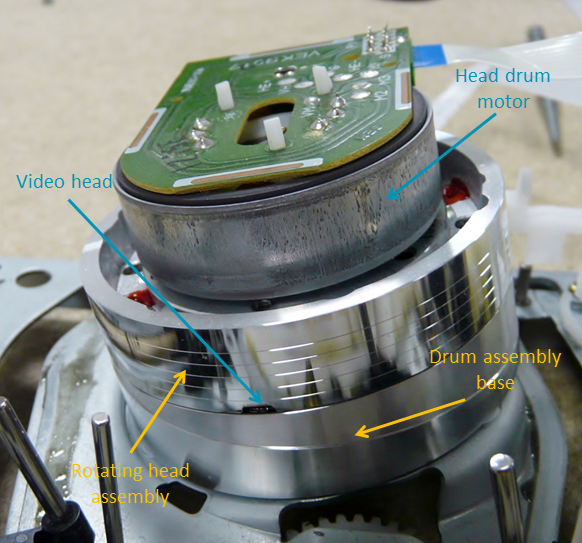EditRe
A Digital Video Cassette Player
The last VHS tape machine was made in 2016: https://www.forbes.com/sites/brittanyhodak/2016/07/23/rip-vhs-worlds-last-vcr-to-be-made-this-month/?sh=9d2840e23da1.
As the article linked to above states, VHS tape is unlikely to have a revival of the type seen in vinyl, for example. However, many of us have tapes of valued family events, and many companies and museums have tapes of historical events.
Many companies offer a service to copy the tape to a more modern digital format such as a DVD or a memory stick but there are a number of issues with this. First, the quality of the transfer will only be what the tape machine, built to a price for a consumer market and probably manufactured many years ago, can produce. Many companies don't even go to the trouble of using 'high-end' machines for the transfer.
Secondly, to transfer a three-hour tape, we need three hours. There is no 'faster than real time' transfer. The fast forward mode in tapes misses frames and leaves noise bars across the screen. For a museum with thousands of tapes, this transfer time is an issue. And related to that, there is no automated tape handling process - tapes must be inserted and ejected by hand and the tape transfer initiated manually. Consumer machines had no remote control feature.
And lastly, without a source of new machines, you are left to buying a dwindling supply of problematic e-Bay machines.
So we looked at how to design a 'new' VCR machine with the aim to:
Provide better than VHS quality from any video tape.
Provide faster than real time transfer of the archiving process.
Provide automated tape handling.
In this article we will discuss the first of those aims - how to provide 'better than VHS' quality.
To begin with, it was decided to use an existing, commonly available mechanism, the Panasonic NV--FJ620. There is nothing special about this machine, it is not high-end, but the schematics were available online and, as mentioned, the players are relatively easily sourced.
.jpg)
Various improvements could be made to the playability of corrupted tapes, such as having two control heads, but that would mean replacing all the servos, so it was decided to leave the mechanism and its servo controllers alone to begin with, and concentrate on decoding the video signal. First, the mechanism was extracted out of the box and fitted into a 3U high rack mount case. This gave us more room for our own electronics.
.jpg)
The AC power supply was run through a switched supply filter to the VCR and our own power supply board was designed to suppy power to our own electronics.
The signal from the video heads is very low amplitude and the head amplifier IC of the Panasonic machine is placed in a screened can directly below the heads. This IC also provides the head switching. Although we could see some improvements could be made to, for example, the noise performance of the amplifier by using more modern ICs, it was decided at this time to use the IC and tap off its amplified (and head-switched) output. The tapped video head signal is fed to small PCB mounted at the rear of the box. This further amplifies, filters and buffers the signal for the main processing board. Two channels are provided for, to process the two head signals individually in the future.
.jpg)
The output of the amplifier is fed to the main processing board (see below).
%20(640x351).jpg)
.jpg)
A prototype VCR player under test.
How does a VHS Player Work?
Analogue tape recording works by passing the signal to be recorded through a coil, which in turn (sorry for the pun), creates a magnetic field proportional to the amplitude of the signal. A mylar tape, coated with ferrous oxide or metallic particles, passes by this head and the particles become aligned, retaining their alignment after the passing by the head.
.jpg)
The maximum frequency that can be recorded depends upon the head gap and the speed the tape passes the head. For audio frequencies up to 20kHz this leads to quite manageable tape speeds, but for video, which needs to record up to about 5MHz, the tape speeds required for practicable head gaps is about 25m/s - a 2400ft (730m) reel of tape would only record about 30 seconds. Despite this, early attempts at analogue tape video recording were made (see above photo of the BBC's VERA from the early 1950s).
It was Ampex who proposed moving the tape head fast, whilst slowing spooling the tape, thereby achieving the necessary signal to tape speed requirement for video bandwidths. The entire video signal must be recorded with no gaps, so, when the VHS system was invented, two video heads are used, each mounted exactly 180deg apart on a drum that is 62mm diameter and rotates at 1500rpm (for PAL systems). The tape is wrapped just over 180deg around the drum, so there is no gap in the recording, and each head records one field of video. Below is a photo of the video head drum assembly from the Panasonic NV-FJ620 player.

gion6 |
.png)
.jpg)
.png)
.png)
.png)
.png)
.jpg)
.jpg)
.jpg)
%20(640x351).jpg)
.jpg)
.jpg)

.png)